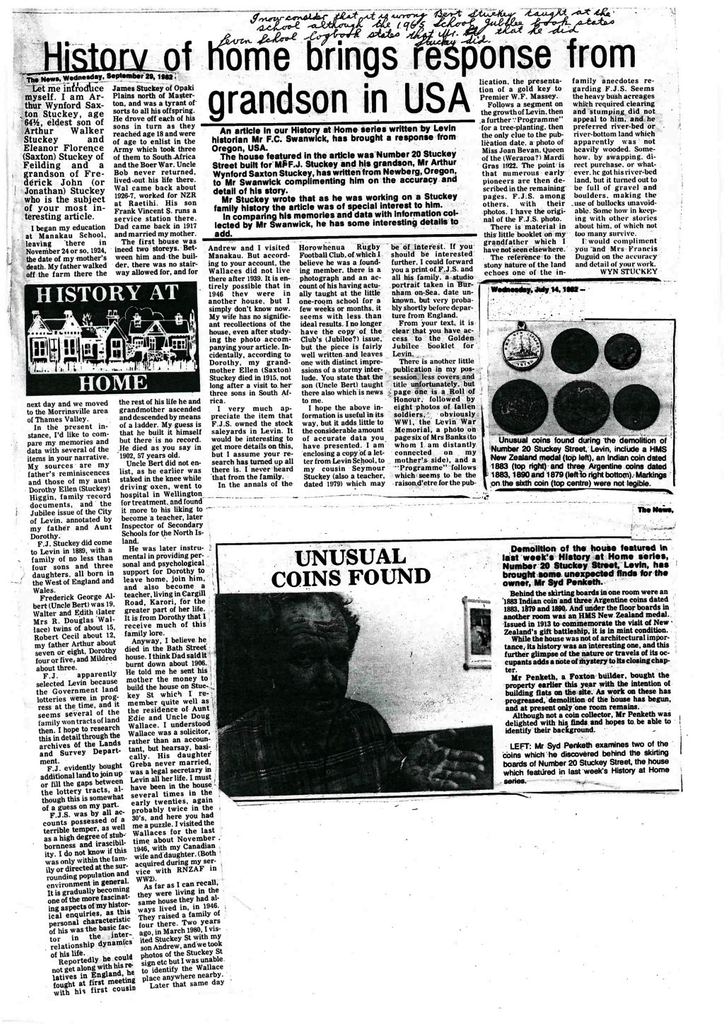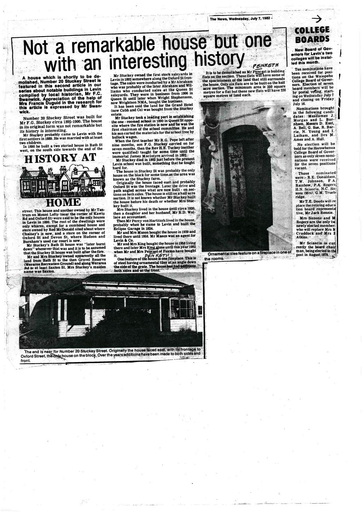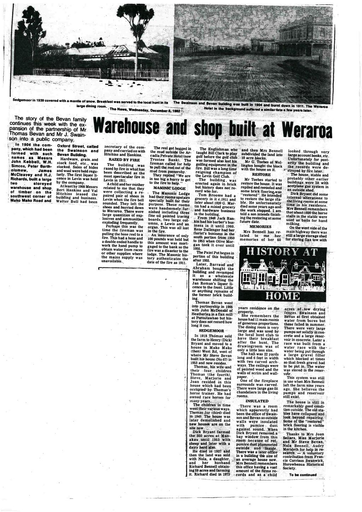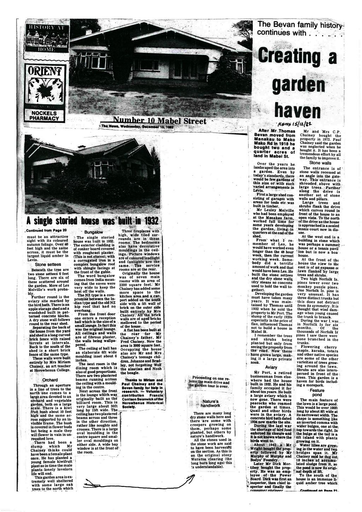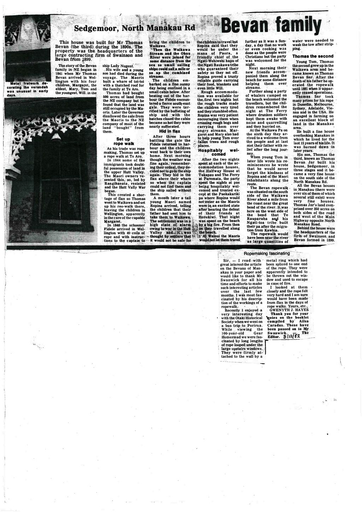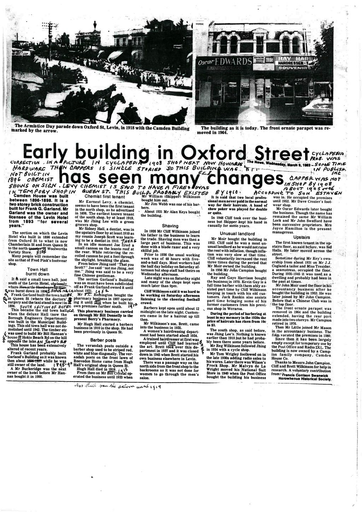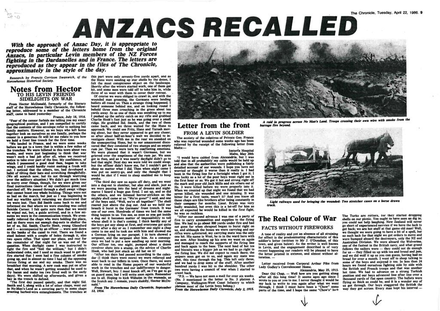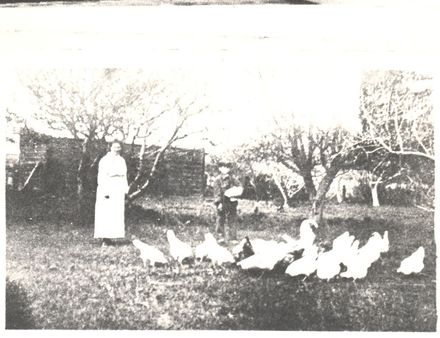History of Home Brings Response from Grandson in USA
- Description
History of Home Brings Response from Grandson in USA
The house featured in the article was Number 20 Stuckey Street built for Mr F.J. Stuckey and his grandson, Mr Arthur Wynford Saxton Stuckey, had written from Newberg, Oregon, to Mr Swanwick complimenting him on the accuracy and detail of his story.Mr Stuckey wrote that as he was working on a Stuckey family history the article was of special interest to him.
In comparing his memories and data with information collected by Mr Swanwick, he has some interesting details to add.
Let me introduce myself. I am Arthur Wynford Saxton Stuckey, age 64½, eldest son of Arthur Walker Stuckey and Eleanor Florence (Saxton) Stuckey of Feilding and a grandson of Frederick John (or Jonathan) Stuckey who is the subject of your most interesting article.
I began my education at Manakau School, leaving there in November 24 or so, 1924, the date of my mother’s death. My father walked off the farm there the next day and we moved to the Morrinsville area of Thames Valley.
In the present instance, I’d like to compare my memories and data with several of the items in your narrative. Mr sources are my father’s reminiscences and those of my Aunt Dorothy Ellen (Stuckey) Higgin, family record documents, and the Jubilee issue of the City of Levin, annotated by my father and Aunt Dorothy.F.J.Stuckey did come to Levin in 1889, with a family of no less than four sons and three daughters, all born in the West of England and Wales.
Frederick George Albert (Uncle Bert) was 19, Walter and Edith (later Mrs. R. Douglas Wallace) twins of about 15, Robert Cecil about 12, my father Arthur about seven or eight, Dorothy four or five, and Mildred about three.
F.J. apparently selected Levin because the Government land lotteries were in progress at the time, and it seems several of the family won tracts of land then. I hope to research this in detail through the archives of the Lands and Survey Department.
F.J. evidently bought additional land to join up or fill the gaps between the lottery tracts, although this is somewhat of a guess on my part.
F.J.S. was by all accounts possessed of a terrible temper, as well as a high degree of stubbornness and irascibility. I do not know if this was only within the family or directed at the surrounding population and environment in general. It is gradually becoming one of the more fascinating aspects of my historical enquiries, as this personal characteristic of his was the basic factor in the inter-relationship dynamics of his life.
Reportedly he could not get along with his relatives in England, he fought at first meeting with his first cousin James Stuckey of Opaki Plains north of Masterton, and was a tyrant of sorts to all his offspring. He drove off each of his sons in turn as they reached age 18 and were of age to enlist in the Army, which took three of them to South Africa and the Boer War. Uncle Bob never returned, lived out his life there. Wal came back about 1926-7, worked for NZR at Raetihi. His son Frank Vincent S. runs a service station there. Dad came back in 1917 and married my mother.
The first house was indeed two storeys. Between him and the builder, there was no stairway allowed for, and for the rest of his life he and grandmother ascended and descended by means of a ladder. My guess is that he built it himself but there is no record. He died as you say in 1902, 57 years old.
Uncle Bert did not enlist, as he earlier was staked in the knee while driving oxen, went to hospital in Wellington for treatment, and found it more to his liking to become a teacher, later Inspector for the North Island.
He was later instrumental in providing personal and psychological support for Dorothy to leave home, join him, and also become a teacher, living in Cargill Road, Karori, for the greater part of her life. It is from Dorothy that I receive much of this family lore.
Anyway, I believe he died in the Bath Street house. I think Dad said it burnt down about 1906. He told me he sent his mother the money to build the house on Stuckey Street which I remember quite well as the residence of Aunt Edie and Uncle Doug Wallace. I understood Wallace was a solicitor, rather than an accountant, but hearsay, basically. His daughter Greba never married, was a legal secretary in Levin all her life. I must have been in the house several times in the early twenties, again probably twice in the 30’s, and here you hand me a puzzle. I visited the Wallaces for the last time about November 1946, with my Canadian wife and daughter. (Both acquired during my service with RNZAF in WW2).
As far as I can recall, they were living in the same house they had always lived in, in 1946. They raised a family of four there. Two years ago, in March 1980, I visited Stuckey Street with my son Andrew, and we took photos of the Stuckey Street sign etc; but I was unable to identify the Wallace place anywhere nearby.
Later that same day Andrew and I visited Manakau. But according to your account, the Wallaces did not live there after 1939. It is entirely possible that in 1946 they were in another house, but I simply don’t know now. My wife has no significant recollections of the house, even after studying the photo accompanying your article. Incidentally, according to Dorothy, my grandmother Ellen (Saxton) Stuckey died in 1915, not long after a visit to her three sons in South Africa.
I very much appreciate the item that F.J.S. owned the stock saleyards in Levin. It would be interesting to get more details on this, but I assume your research has turned up all there is. I never heard that from the family.
In the annals of the Horowhenua Rugby Football Club, of which I believe he was a founding member, there is a photograph and an account of his having actually taught at the little one-room school for a few weeks or months, it seems with less than ideal results. I no longer have the copy of the Club’s (Jubilee?) issue, but the piece is fairly well written and leaves one with distinct impressions of a stormy interlude. You state that the son (Uncle Bert) taught there also which is news to me.
I hope the above information is useful in its way, but it adds little to the considerable amount of accurate data you have presented. I am enclosing a copy of a letter from Levin School, to my cousin Seymour Stuckey (also a teacher, dated 1979) which may be of interest. If you should be interested further, I could forward you a print of F.J.S. and all his family, a studio portrait taken in Burnham-on-Sea, date unknown, but very probably shortly before departure from England.
From your text, it is clear that you have access to the Golden Jubilee booklet for Levin.
There is another little publication, less covers and title unfortunately, but page one is a Roll of Honour, followed by eight photos of fallen soldiers, obviously WW1, the Levin War Memorial, a photo on page six of Mrs Banks (to whom I am distantly connected on my mother’s side), and a “Programme” follows which seems to be the raison d’etre for the publication, the presentation of a gold key to Premier W.F. Massey.
Follows a segment on the growth of Levin, then a further “Programme” for a tree-planting, then the only clue to the publication date, a photo of Miss Joan Bevan, Queen of the (Weraroa?) Mardi Gras 1922. The point is that numerous early pioneers are then described in the remaining pages. F.J.S. among others, with their photos. I have the original of the F.J.S. photo.
There is material in this little booklet on my grandfather which I have not seen elsewhere.
The reference to the stony nature of the land echoes one of the in-family anecdotes regarding F.J.S. Seems the heavy bush acreages which required clearing and stumping did not appeal to him, and he preferred river-bed or river-bottom land which apparently was not heavily wooded. Somehow, by swapping, direct purchase, or whatever, he got his river-bed land, but it turned out to be full of gravel and boulders, making the use of bullocks unavoidable. Somehow in keeping with other stories about him, of which not too many survive.
I would compliment you and Mrs Francis Duguid on the accuracy and detail of your work.
UNUSUAL COINS FOUND
The News: 14 July 1982

 Demolition of the house featured in last week’s History at Home series, Number 20 Stuckey Street, Levin, has brought some unexpected finds for the owner, Mr Syd Penketh.
Demolition of the house featured in last week’s History at Home series, Number 20 Stuckey Street, Levin, has brought some unexpected finds for the owner, Mr Syd Penketh. Behind the skirting boards in one room were an 1883 Indian coin and three Argentine coins dated 1883, 1879 and 1890. And under the floor boards in another room was an HMS New Zealand medal. Issued in 1913 to commemorate the visit of New Zealand’s gift battleship, it is in mint condition.
While the house was not of architectural importance, its history was an interesting one, and this further glimpse of the nature of travels of its occupants adds a note of mystery to its closing chapter.
Mr Penketh, a Foxton builder, bought the property earlier this year with the intention of building flats on the site. As work on these has progressed, demolition of the house has begun, and at present only one room remains.
Although not a coin collector, Mr Penketh was delighted with his finds and hopes to be able to identify their background.
[Handwritten note from Mr F.C. Swanwick: I now consider that it is wrong Bert Stuckey taught at the school although the 1965 School Jubilee book states Levin School logbook states that Mr. Stuckey did.]
Identification
- Date
- September 29, 1982
Taxonomy
- Community Tags


